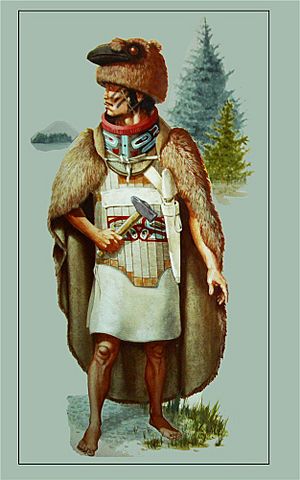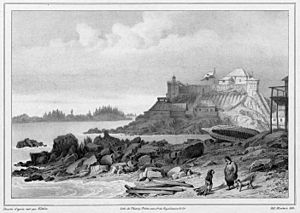Battle of Sitka facts for kids
Quick facts for kids Battle of Sitka |
|||||||
|---|---|---|---|---|---|---|---|
| Part of the Russian colonization of the Americas and the American Indian Wars | |||||||
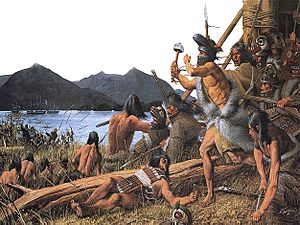 Battle of Sitka by Louis S. Glanzman, 1988 |
|||||||
|
|||||||
| Belligerents | |||||||
| Tlingit Kiks.ádi Clan | |||||||
| Commanders and leaders | |||||||
| Katlian | |||||||
| Strength | |||||||
| 150+ Russians 400 Aleuts 14 guns |
750–800 (estimated) | ||||||
| Casualties and losses | |||||||
| 12 killed, many wounded | unknown | ||||||
The Battle of Sitka was a major fight between Russian settlers and the native Tlingit people in 1804. It happened after the Tlingit destroyed a Russian trading post two years earlier. The main groups involved were the Kiks.ádi Clan of the Tlingit nation and the Russian-American Company, helped by the Imperial Russian Navy. This battle was a key event in the Russian expansion into Alaska.
Contents
Why did the Battle of Sitka happen?
Early Russian Settlement in Alaska
The Kiks.ádi people had lived on Baranof Island (called Sheetʼká Xʼáat'i by the Tlingit) for about 11,000 years. In 1795, Alexandr Baranov, who managed the Russian-American Company, visited the island. He was looking for new places to hunt sea otters. Baranov paid the Tlingit for land rights. He wanted to stop other traders from coming to the island.
On July 7, 1799, Baranov returned to Sitka Sound. He had 100 Russians, 700 Aleuts, and 300 other native allies. They sailed on several ships, including the Olga, Ekaterina, and Orel. They also had about 550 small boats called baidarkas.
The group chose a spot about 7 miles (11 kilometers) north of the Tlingit's main fort. They built a settlement called "Redoubt Saint Michael". This outpost had a large warehouse, a blacksmith shop, barracks, and a stockade. It also had a block house and homes for hunters and Baranov.
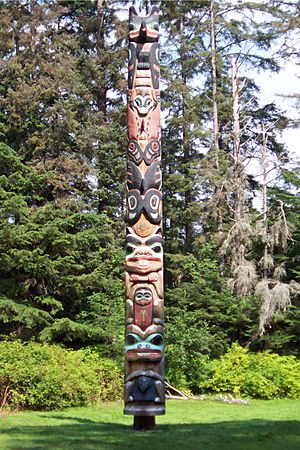
At first, the Tlingit (whom the Russians called Koloshi) welcomed the newcomers. But soon, they grew to dislike the Russians. The Kiks.ádi didn't like that Russian traders took native women as wives. Other Tlingit clans teased the "Sitkas," calling them the outsiders' kalga, or slaves. The Kiks.ádi also realized that the Russians expected them to work for free. Competition for the island's resources also increased.
The 1802 Attack on the Russian Post
Despite some small Tlingit attacks in 1799, the Russian trading post grew. Baranov had to return to Kodiak (the capital of Russian America) in 1800. He left 25 Russians and 55 Aleuts at the post. By spring 1802, the settlement had 29 Russians, 3 British deserters, 200 Aleuts, and some Kodiak women.
There were rumors that the British, from the Hudson's Bay Company, met with northern Tlingit clans in 1801. They supposedly offered guns and gunpowder to the Tlingit. In return, they wanted to be the only ones trading furs.
In June 1802, Tlingit warriors attacked the Russian fort. They were led by Skautlelt (Shḵ'awulyéil) and Kotleian. They killed many people, stole sea otter furs, and burned the settlement. A ship being built was also destroyed. A few Russians and Aleuts who were hunting or fled into the forest survived. They reached safety and told Baranov about the attack. A British captain, Barber, helped rescue some survivors and furs. He demanded a ransom of 10,000 rubles for their return.
How did the Russians plan their revenge?
Building a New Tlingit Fort
After the Tlingit victory, a Tlingit Shaman named Stoonook knew the Russians would return. He told the clan to build a new fort. This fort needed to withstand cannon fire and have plenty of water. Even though some disagreed, the Shaman's idea won. The Kiks.ádi prepared for war. They asked their allies for help, but no one came. They would face the Russians alone.
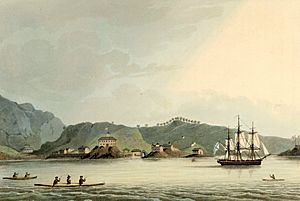
The Tlingit built Shís'gi Noow (the "Fort of Young Saplings"). It was about 240 feet by 165 feet (73 by 50 meters). They placed it near the mouth of the Indian River. This spot had long, shallow gravel beaches. They hoped the shallow water would keep Russian ships from getting too close. They used about 1,000 native spruce logs to build 14 buildings and a thick palisade wall.
The Kiks.ádi planned to check the Russians' strength at their old fort, Noow Tlein. Then, they would move to the new fort for safety.
The Russian Fleet Arrives
Baranov returned to Sitka Sound in late September 1804. He was on the warship Neva, commanded by Lieutenant Commander Yuri Feodorovich Lisyansky. The Neva was joined by the Ermak and two other smaller, armed sailing ships. They carried 150 Russian fur traders and 400–500 Aleuts in 250 baidarkas.
On September 29, the Russians landed at the Tlingit's winter village. Lisyansky named the site "Novo-Arkhangel'skaya Mikhailovskaya" (New Archangel Saint Michael). Baranov sent people to talk to the Tlingit. He offered to negotiate for the Noow Tlein site, but the Tlingit refused. They wanted to delay the Russians. This would allow them to move to the "sapling fort" without the Russians noticing.
However, a small group of Tlingit went to get gunpowder from an island. They were spotted by the Russians and a brief fight broke out. A shot hit their canoe, causing the gunpowder to explode. Everyone in the group died. These were important young men and an elder. Baranov's messengers then told the Tlingit that the Russian ships would soon fire on the new fort.
What happened during the Battle of Sitka?
Day One: The Ground Attack
Around October 1, the Neva was pulled closer to the Indian River. A Russian landing party, led by Baranov, attacked the Tlingit fort. They were met with continuous gunfire. The Aleuts panicked and ran back to their boats.
The Kiks.ádi warriors, led by their new War Chief Ḵʼalyaan (Katlian), fought back. Katlian wore a Raven mask and carried a blacksmith's hammer. They rushed out of Shis'kí Noow and fought hand-to-hand. Another group of Tlingit attacked from the nearby woods. Baranov was badly hurt. The Russians had to retreat to the water's edge. The Neva fired its cannons to cover their escape. Twelve attackers were killed and many injured. The Russians had to leave some small cannons on the beach. Lisyansky reported only two killed but fourteen wounded.
That night, the Tlingit celebrated their success in pushing back the Russians.
Day Two: Cannon Fire and Truce Offers
Baranov's injuries meant he couldn't continue leading. Lieutenant Commander Lisyansky took command. He ordered his ships to start firing cannons at the Tlingit fort. They fired "ranging shots" to find the best distance. The fort's walls were too strong for the cannonballs to break through. Lisyansky noted that the fort was "so thick and strong, that the shot from my guns could not penetrate it."
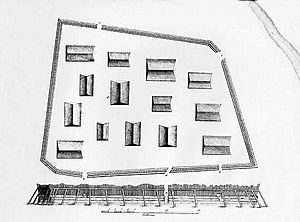
In the early afternoon, the Russians stopped firing. They sent a messenger with a flag of truce. The message demanded the Tlingit surrender, but the Tlingit refused. The Tlingit then demanded the Russians surrender, which was also refused. The Russian cannon fire continued until nightfall.
That night, the Kiks.ádi met. They believed the Russians had lost too many men to attack on the ground again. The Tlingit had hoped to hold out until northern clans arrived. But they were running low on gunpowder. This made it hard to win. They decided to change their plan. Instead of losing on the battlefield, they would escape into the forest. They would then build a new settlement on the northern part of the island.
Day Three: Secret Departures
The Neva and other ships started firing on the Tlingit fort again at sunrise. They stopped sometimes to offer peace, but the Kiks.ádi refused. Unknown to the Russians, the Tlingit's elderly and young children had already started walking to G̱aajaa Héen (Old Sitka). That night, the Clan leaders met again. They planned for mothers with babies to leave the next morning.
Day Four: The Tlingit Escape
The naval cannon fire began at daybreak. It stopped sometimes for the Russians to offer peace, but the Tlingit kept refusing. That afternoon, the Tlingit said they were tired of fighting. They agreed to leave Shís'gi Noow the next day. After sunset, the natives had their last meeting in the fort. The elders praised their clansmen for defending their homeland. The Clan sang a last song, ending with a loud drum roll and a wail. The Russians thought this meant they had surrendered.
But the Tlingit secretly left the fort that night, without being seen.
What happened after the Battle?
The "Sitka Kiks.ádi Survival March"
The Kiks.ádi began their retreat on the evening of October 4. The Russians landed many troops to secure the beach and explore the fort. To their surprise, no natives were found. The Tlingit had started what is now called the "Sitka Kiks.ádi Survival March."
On October 8, Captain Lisyansky visited the empty Tlingit fort. He estimated about eight hundred males had lived there. He wrote about finding murdered children, believing they were killed so their cries wouldn't reveal the Tlingit's escape.
The fort was destroyed so it couldn't be used against the Russians again. The Neva sailed out of Sitka Sound on November 10.
In January 2021, the fort's location was rediscovered using special equipment.
The Tlingit's journey involved hiking west from Gajaa Héen to Daxéit, their fishing camp. From there, their exact path across the mountains to Cháatl Ḵáa Noow (the Kiks.ádi "Halibut Man Fort") is not fully known. However, a coastal route around northwest Baranof Island seems most likely. This would have helped them avoid dense forests. Canoes made from red cedar trunks helped them cross the ocean to Chichagof Island.
Some warriors stayed near Noow Tlein after the battle. They wanted to bother the Russian settlers and stop them from chasing the Kiks.ádi. Soon after, eight Aleut trappers were killed. Another was shot near New Archangel. From then on, Russian hunting parties went out in large groups, always watching for attacks. The Kiks.ádi encouraged other Tlingit clans to avoid the Russians.
Russian Alaska and Its Legacy
On top of the hill at Noow Tlein, the Russians built their own fort. It had a high wooden wall with three watchtowers. These towers had 32 cannons to defend against Tlingit attacks.
By summer 1805, eight buildings were inside the fort. These included workshops, barracks, and the Governor's Residence. The Kiks.ádi mostly stayed away from the growing settlement until 1821. The Russians invited the Tlingit to return to Sitka. They wanted to benefit from the natives' hunting skills and stop the attacks. Sitka became the new capital of Russian America in 1808.
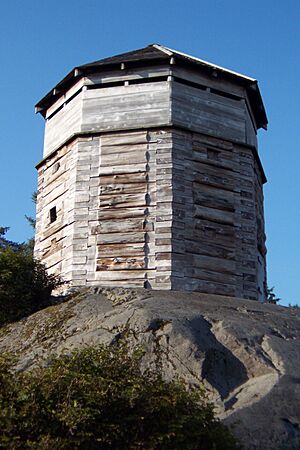
Tlingit people who returned were allowed to live in a part of the village below the heavily guarded fort. Russian cannons were always pointed at the natives as a reminder of their defeat. The Kiks.ádi provided food and otter furs to the Russians. In return, the Russians introduced the Tlingit to their culture and the Russian Orthodox Church. Small acts of Tlingit aggression continued until 1858. There was one significant uprising in 1855, but it was quickly stopped.
In 1867, Russian America was sold to the U.S. Many Tlingit elders believed that "Castle Hill" was the only land Russia had the right to sell. Native land claims were not settled until the late 20th century.
The 1880 census showed 43 Tlingit living near the Indian River, their traditional summer fishing camp.
Honoring the Past
U.S. President Benjamin Harrison set aside the Shís'gi Noow site for public use in 1890. Sitka National Historical Park was created there on October 18, 1972. It was made "...to remember the Tlingit and Russian experiences in Alaska." Today, the K'alyaan Pole stands at the Shís'gi Noow site. It honors the Tlingit people who died. Ta Eetí, a memorial for the Russian sailors, is across the Indian River.
In September 2004, for the battle's 200th anniversary, descendants from both sides held a Tlingit "Cry Ceremony." They formally mourned their lost ancestors. The next day, the Kiks.ádi held a reconciliation ceremony. This was to "put away" their two centuries of sadness.
Historic Sites to Remember
- National Register of Historic Places #NPS–66000162 — "Baranof Castle Hill" site
- National Register of Historic Places #NPS–66000164 — "Battle of Sitka" site
- National Register of Historic Places #NPS–66000166 — Old Sitka ("Redoubt Saint Michael") site
Images for kids
See also
 In Spanish: Batalla de Sitka para niños
In Spanish: Batalla de Sitka para niños


